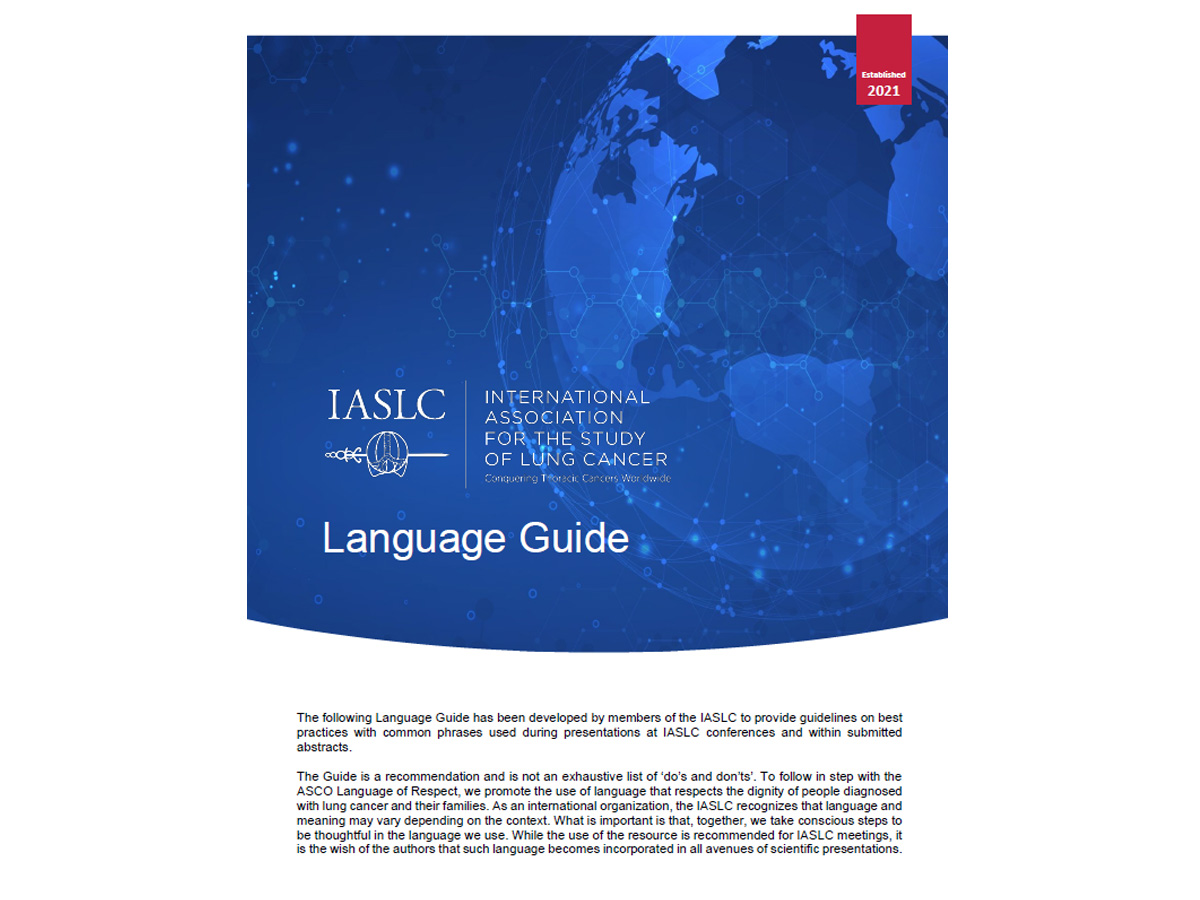America’s decades-long war on smoking has been remarkably successful in reducing smoking rates, but the unintended consequences include stigmatizing people who smoke and people with lung cancer. Sadly, those dealing with lung cancer continually encounter hurtful statements born of ignorance or thoughtlessness (questions such as, “Do you smoke?”), along with the burden of having to repeatedly explain and defend themselves to people who should know better.
To begin to correct this complex situation, the IASLC has produced its first Language Guide to promote best practices in all written and spoken language for submitted abstracts and presentations at its conferences, as well as of all members of the lung cancer community. The goal is simple but ambitious: to move the healthcare profession and the broader culture away from using judgmental or denigrating language when speaking to or about people living with lung cancer or any other disease, as that can undermine the emotional well-being of patients and is not consistent with modern, patient-centric medicine.
The Guide is not long, dense, or difficult to understand. It encourages everyone to “take conscious steps to be thoughtful in the language we use,” and boils down to four simple, subtle principles:
- Use Person-First Language: For example, instead of “lung cancer patient,” use “patient/person with lung cancer.”
- Eliminate Blaming Language: For example, replace “patient failed treatment” with “treatment failed patient.”
- End Stigma: For example, instead of “smoker,” use “person who smokes.”
- Equity: Follow best practices regarding race, ethnicity, gender, socioeconomic, and geographic descriptions to promote cultural humility and sensitivity.
An Evolution of Respect
Jill Feldman is a familiar figure in the lung cancer community due to her success as an activist as well as to her knee-buckling personal story. As a young teen, she lost her father to lung cancer and had her first experience with the stigma when a friend remarked that Jill’s father caused his own disease by smoking. Ms. Feldman was a young adult when her mother also succumbed to the disease. This led her to a second career in lung cancer advocacy on behalf of both patients and research. It was a good fit—her undergraduate degree in strategic communication, communicate, and collaborate with other patients, healthcare providers, and policymakers at conferences, colloquia, and informal gatherings. Then, in an exceptional incident of existential irony, Ms. Feldman was diagnosed with lung cancer at age 39.
Due to her own work and that of many others in many fields, she faced a much different future than her parents, who died within months of their diagnoses. With raised awareness, expanded research efforts, and new treatments, the traditionally underserved lung cancer community finally had the resources available to make hope a real option. For more than a decade, Ms. Feldman has lived with lung cancer while working, speaking out, and pushing for reforms. Although she is no longer devasted by thoughtless comments, she still feels the sting when her four children encounter lung cancer stigma.
“We are not and should not be defined by our disease,” she said. “We are not solely the disease; we are so much more.”
The IASLC Language Guide is based on feedback from Ms. Feldman and others with expertise as healthcare consumers and providers. Its intent is not to blame, but to educate, Ms. Feldman said, so that traditional oncology jargon will be replaced with more inclusive and empowering terms.
“Over time, the patient voice has become more valued and more credible,” she said, “and we are really trying to help medical professionals and scientists understand that our input will make their research, its results, and their treatments more relevant to patients. When patients and families learn of IASLC supporting and implementing these new language guidelines, that alone will create a sense of trust in our community, and the feeling that, from the top down, they care about us and they are listening to us.”
Ms. Feldman’s best hope for the IASLC Language Guide is that “it will be embodied and modeled by our best leaders, and things will change for the better—for lung cancer, cancer in general, and even well beyond.”
Relearning Scientific Language
Accepting criticism is not always easy, even when it is constructive and well-intended. Although it may be uncomfortable for anyone, including healthcare professionals, countering one’s own defensiveness with honest self-reflection can lead to better outcomes and advances. It was from this perspective and a platform of sustained behavioral oncology research in lung cancer that Jamie Studts, PhD, and Jamie Ostroff, PhD, contributed to the development of the IASLC Language Guide.
For years, Dr. Studts, of the University of Colorado’s Medical Oncology Division, has been exploring behaviors surrounding lung cancer and its treatment. With a background in tobacco-addiction recovery and a long stint working in Kentucky’s deeply ingrained tobacco culture, he has heard patients’ stories of the scorn directed at them by friends and strangers. He also has seen firsthand the negative effects that can flow from reflexively applied medical terminology, and even from counterproductive imagery in pamphlets and advertisements. Dr. Studts sees the IASLC Language Guide as exactly the sort of cost-effective, no-side-effects “treatment” that can help blunt the harms associated with insensitive language and begin to turn the course of this “disease” of terminology—not a cure, but a powerful adjunct to healing.
According to Dr. Studts, society tends to believe that lung cancer is “about tobacco,” meaning that “people do this to themselves, so they do not deserve our support and compassion,” and they know that the disease is “a devastating illness and people die, which can lead to fatalism, pessimism, and just a real sense of futility.” However, the tide is turning, and there is more reason to justify changes in how society views lung cancer. On the upside, he is excited about novel therapeutics improving treatment outcomes. “This is an area where lung cancer is leading the entire landscape of oncology,” he said, “and we want that rational optimism to overcome the fatalism, stigma, and bias that has plagued this community for too long.”
Moving toward a paradigm of respectful, considerate language, Dr. Studts said, is fundamental to improving overall care for patients.
“The language we have been using does not allow a more complex story to emerge about people’s real experiences, and that tends to isolate and alienate the very people we are trying to help,” he said. “And, that stigma has impacted policy and the allocation of research dollars and funding over time.”
About 2,000 miles to the east at Memorial Sloan Kettering Cancer Center in New York City, Dr. Ostroff, a clinical psychologist, has also been grappling with the language and stigma of lung cancer. She describes herself as “a card-carrying tobacco-control clinician, researcher, and educator dedicated to reducing the morbidity and mortality associated with tobacco use” and credits “thoughtful, assertive patient advocates for prompting me to reconcile my two spheres of professional interest—psycho-oncology and cancer prevention—see the unintended consequences of tobacco control on the psychological well-being and quality of care for individuals that struggle with tobacco dependence.”
Her investigations on the nature, consequences, and strategies to prevent and mitigate stigma helped illuminate the data on which the IASLC Language Guide is based. To her, the guide is a necessary awareness-raising tool that comes not a second too soon.
“This is an incredible milestone and an acknowledgment of the importance of patients and academics forming partnerships for change,” she said. “The next step is to move it to the international stage, so there can be a global improvement in ending the stigma of lung cancer.”
Dr. Ostroff is most proud of the fact that the guide was produced in collaboration with Ms. Feldman and other patient advocates.
“We came together from different places, with different methods and different training, but we all agree that words matter, and that it is possible to change the language we use to talk to and about persons with lung cancer, as well as about people who use tobacco,” Dr. Ostroff said. “And we can do that in a way that that conveys respect, inclusivity, and equity.”






